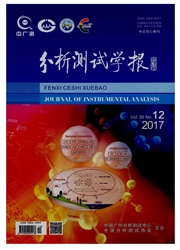

 中文摘要:
中文摘要:
对RAW264.7细胞在不同状态(正常、炎症、给药)下的甘油磷脂成分进行分析,寻找相关的潜在病理药理标志物,阐明二苯基庚烷A在抗炎过程中对甘油磷脂代谢的影响。实验分为空白组(C)、炎症模型组(L)、二苯基庚烷A给药组(D)和布洛芬给药组(B,阳性对照药组)4组。空白组和炎症组给予新鲜培养基,给药组分别给予新配含20μg/m L二苯基庚烷A和100μg/m L布洛芬的培养基,1 h后,炎症模型组和给药组按终浓度为0.5μg/m L加入脂多糖(LPS)培养,24 h后,运用修饰后的Bligh-Dyer方法提取不同状态下RAW264.7细胞的甘油磷脂成分,并通过超高效液相色谱-四极杆飞行时间质谱联用技术(UPLC-Q/TOF MS)在正负离子模式下对甘油磷脂进行一级(MS)和二级(MS/MS)质谱分析。结合二级质谱裂解数据、元素组成、数据库比对等方法鉴定磷脂成分,再通过主成分分析法(PCA)、偏最小二乘判别分析(PLS-DA)、正交偏最小二乘判别分析(OPLS-DA)以及t检验筛选潜在的甘油磷脂生物标志物。结果显示,炎症组与空白组比较得到27个潜在病理标志物,二苯基庚烷A给药组与炎症组比较得到23个潜在药理标志物,布洛芬给药组与炎症组比较得到17个潜在药理标志物,主要包括磷脂酰胆碱(PC)、溶血磷脂酰胆碱(lyso PC)、磷脂酰乙醇胺(PE)、溶血磷脂酰乙醇胺(lyso PE)。研究表明二苯基庚烷A在抗炎过程中引起了甘油磷脂代谢的明显变化,而这些代谢变化与炎症的发生发展密切相关。
 英文摘要:
英文摘要:
The study aims to illustrate the effect of diphenylheptane A on the glycerophospholipids metabolism in the inflammatory process through analyzing glycerophospholipids components of RAW264. 7 cells under different status ( control, inflammation, administration) and screening poten- tial pathological and pharmacological biomarkers. RAW264.7 cells were randomly divided into four groups : control group ( C), inflammation group ( L), diphenylheptane A ( D), ibuprofen ( B, posi- tive control). C and L were treated with fresh medium while D and B were treated with medium con- taining 20 ixg/mL diphenylheptane A or 100 I~g/mL ibuprofen, respectively. 1 h later, lipopolysac- charide (LPS) was added to L, D and B at a final concentration of 0.5 ~g/mL. 24 h later, glycero- phospholipids in RAW264.7 cells of four groups were extracted by modified Bligh - Dyer method and analyzed by ultra performance liquid chromatography tandem quadrupole time -of- flight mass spec- trometry( UPLC -Q/TOF MS) in both positive and negative ion modes. Then, glycerophospholipids components were identified by combination of MS/MS fragment ions information, element composition in MassLynx 4. 1 and the Lipid Maps database. Finally, potential pathological and pharmacological biomarkers were screened by unsupervised principal component analysis (PCA) , supervised partial least squares -discriminate analysis( PLS -DA), supervised orthogonal partial least squares discriminate analysis (OPLS- DA), and Student's t- test(P 〈 0.05 ). The results showed that 27 potential pathological biomarkers were found by comparing C and L, 23 potential pharmacological biomarkers were found by comparing D and L, and 17 potential pharmacological biomarkers were found by com- paring B and L. The biomarkers mainly included phosphatidyleholine(PC) , lysophosphatidylcholine ( lysoPC), phosphatidylethanolamine (PE) and lysophosphatidylethanolamine (lysoPE). It was found that diphenylheptane A led to obvious chan
 同期刊论文项目
同期刊论文项目
 同项目期刊论文
同项目期刊论文
 Rapid identification of erythrocyte phospholipids in Sprague–Dawley rats by ultra high performance l
Rapid identification of erythrocyte phospholipids in Sprague–Dawley rats by ultra high performance l Effects of berberine and pomegranate seed oil on plasma phospholipid metabolites associated with ris
Effects of berberine and pomegranate seed oil on plasma phospholipid metabolites associated with ris Phenolic Compounds from the Flowers of Bombax malabaricum and Their Antioxidant and Antiviral Activi
Phenolic Compounds from the Flowers of Bombax malabaricum and Their Antioxidant and Antiviral Activi 期刊信息
期刊信息
